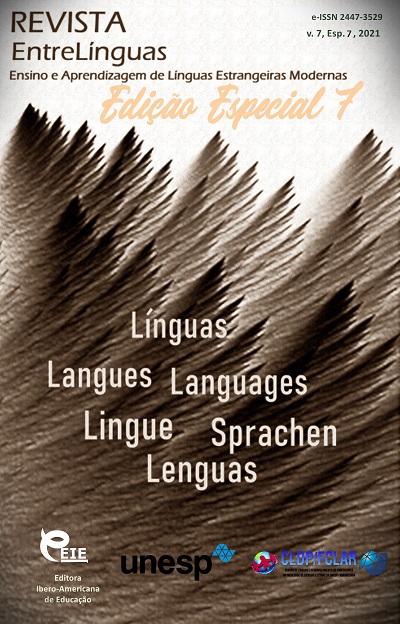La vida vegetal en la cosmovisión onomástica de los tártaros
DOI:
https://doi.org/10.29051/el.v7iesp.7.16331Palabras clave:
Lengua tártara, Onomástica, Linguoculturología, Etnocultura, FitonimiaResumen
La cosmovisión onomástica refleja los aspectos más importantes de la cultura y la historia, la perspectiva del mundo y la psicología de las personas. El significado de algunas unidades onomásticas contiene capas informativas ocultas del pensamiento mitológico arcaico. Uno de los grupos más importantes entre esas unidades incluye nombres del mundo vegetal. Este artículo tiene como objetivo demostrar la especificidad de la representación de la vida vegetal en la cosmovisión onomástica de los tártaros. El análisis implica la interpretación del significado de topónimos y antropónimos conservando las repercusiones de las creencias de los antiguos turcos. El análisis se realizó sobre material lingüístico y culturológico mediante un complejo de métodos y técnicas interdisciplinares. El análisis realizado reveló que la tradición de utilizar nombres de flora como nombres propios tiene su origen en las formas arcaicas de la mitología, que concibió un árbol como símbolo del dios supremo. Las antiguas ideas ingenuas de los turcos se transmitieron a la onomástica moderna de los tártaros. Debido a su estabilidad, el sistema toponímico conserva las primeras vistas. En el sistema antroponímico, a pesar del hecho de que muchos de los antropónimos antiguos dejaron de usarse, las tradiciones y los motivos de los nombres continuaron cuando se tomaron prestados antropónimos de otros idiomas.
Descargas
Citas
(1969). Ancient Turkic Dictionary. Leningrad, 676 p.
(1993). “Dialect Dictionary of the Tatar Language” (in Tatar), 789 p.
BLAGOVA, G. Anthroponymic System as Projection of Cosmological and Social Views of the Ancient Turks. Comparative-historical Grammar Book of the Turkic Languages. The Ancient Turkic Proto-Language. The Worldview of the Ancient Turkic Ethnos by the Language Data”, Moscow, 660–754. 2006.
GALIULLINA, G., YUSUPOVA, A., KHADIEVA, G., & DENMUKHAMETOVA, E. Turko-Tatar Vocabulary as Cognitive Mapping of the National Mentality. Kazan, 120 p. 2001.
ISAEV, Y. Phytonymic Conceptuary as Dictionary of a New Type (a case study of the Chuvash and Tatar Languages. Cheboksary, 191 p. 2013.
ISMAGILOVA, A., GALIULLINA, G., & KUZMINA, KH. Functional potential of mother tongue in conditions of bilingualism among youth of the Republic of Tatarstan. Modern Journal of Language Teaching Methods, 66–70. 2016.
Kamilovna Khadieva, G., Raisovna Galiullina, G., Khatipovna Kuzmina, K., & Airatovna ABDRAKHMANOVA, A. Metaphoric Terms in Tatar Toponyms as the Reflection of the National World-View. Research in Applied Linguistics, 10(Proceedings of the 6th International Conference on Applied Linguistics Issues (ALI 2019) July 19-20, 2019, Saint Petersburg, Russia), 802-808. 2019.
Khatipovna Kuzmina, K., Kamilovna Khadieva, G., Raisovna Galiullina, G., & Ramilevna AKHUNZHYANOVA, D. The History of the Development of Literary Tatar Language in the 20th Century (Based on the Example of the Language of Literary Works). Research in Applied Linguistics, 10(Proceedings of the 6th International Conference on Applied Linguistics Issues (ALI 2019) July 19-20, 2019, Saint Petersburg, Russia), 847-854. 2019.
KHVOLSEN, D. News on the Khazars, the Burtas, the Bulgars, the Magyars, the Slavs, and the Rus by Abu-Ali Ben-Omar Ibn-Dast. Saint-Petersburg. 1869.
KOVALEVSKIY, A. Book by Akhmed Ibn Fadlan on his Journey to the Volga in 921-922. Khar’kov, 345 p. 1956.
MUKHAMETOVA, I. I., KADIROVA, E. K., YUSUPOV, A. F., & ALKAYA, E. SOMATISMS IN THE OLD TATAR LANGUAGE. Revista TURISMO: Estudos e Práticas, 1, 1-5. 2019.
SATTAROV, G. Anthroponyms of the Tatar Autonomous Soviet Socialist Republic. (in Tatar), Kazan, 296 p. 1973.
SUPERANSKAYA, A., STALTMANE, V., PODOLSKAYA, N., & SULTANOV, A. Theory and Methods of Onomastic Research. Moscow, 254 p. 2007.
YERBULATOVA, I., KIRILLOVA, Z., & SAHIN, L. National and Cultural Realias of Translations into Tatar. Humanities and Social Sciences Reviews, 7(6), 984–987. 2019.
YUSUPOVA, A. S., GALIULLINA, G. R., & DENMUKHAMETOVA, E. N. Representation of national mentality in Turkic-Tatar vocabulary. Life Sci J, 11(7), 506-508. 2014.
Descargas
Publicado
Cómo citar
Número
Sección
Licencia

Esta obra está bajo una licencia internacional Creative Commons Atribución-NoComercial-CompartirIgual 4.0.
Os manuscritos aceitos e publicados são de propriedade da Revista EntreLínguas. Os artigos publicados e as referências citadas na Revista EntreLínguas são de inteira responsabilidade de seus autores.
Transferência de direitos autorais – autorização para publicação
Caso o artigo submetido seja aprovado para publicação, já fica acordado que o(s) autor(es) autoriza(m) a UNESP a reproduzi-lo e publicá-lo na EntreLínguas, entendendo-se os termos “reprodução” e “publicação” conforme definição respectivamente dos incisos VI e I do artigo 5° da Lei 9610/98. O artigo poderá ser acessado pela rede mundial de computadores (Internet), sendo permitidas, a título gratuito, a consulta e a reprodução de exemplar do artigo para uso próprio de quem a consulta, desde que haja a citação ao texto consultado. Essa autorização de publicação 328 EntreLínguas, Araraquara, v. 1, n .2, p. 323-328, jul./dez. 2015 não tem limitação de tempo, ficando a UNESP responsável pela manutenção da identificação do(s) autor(es) do artigo. Os artigos publicados e as referências citadas na Revista EntreLínguas são de inteira responsabilidade de seus autores.











